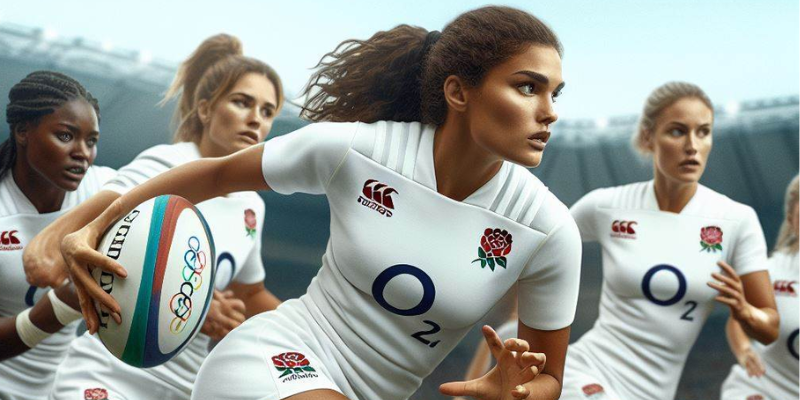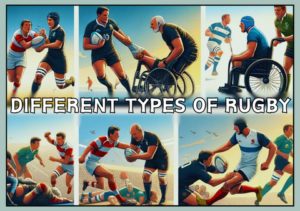There are different types of rugby that use the traditional oval shaped ball: rugby union (15 a-side), rugby union 7s, rugby union 10s, rugby league (13 aside), touch rugby, beach rugby, tag rugby, and wheelchair rugby.
Each variant brings its own unique characteristics, from the number of players to the rules, seasonality, and competition formats
Different Types of Rugby
We’ll look at different rugby types and explain what makes it different from the others.
Union Rugby

- Description: Union Rugby, also known as Rugby Union, is the traditional form of the game.
- Players: Played with 15 players on each team.
- Characteristics: Physicality, strategic gameplay, strong emphasis on teamwork.
- Governing Body: Governed by World Rugby.
- Popularity: Widely played at both amateur and professional levels globally.
The game is characterized by its strong emphasis on teamwork, with players working together to advance the ball up the field and score points by crossing the opponent’s try line and touching the ball down.
Union Rugby is governed by World Rugby, the international governing body for the sport, which sets the rules and regulations for competitions at all levels.
It enjoys widespread popularity globally, with both amateur and professional leagues attracting large audiences and dedicated fan bases.
League Rugby
- Description: League Rugby is popular in countries like Australia and New Zealand.
- Players: Played with 13 players per team.
- Characteristics: Faster pace, greater emphasis on speed and agility, different rules regarding tackles and scoring.
- Popularity: Particularly strong in certain regions, with dedicated professional leagues.
It involves 13 players per team, resulting in a faster-paced and more open style of play compared to Union Rugby.
League Rugby places a greater emphasis on speed, agility, and attacking play, with different rules regarding tackles and scoring.
The Rugby League International Federation (RLIF) governs the game, and it boasts dedicated professional leagues in various countries, with a strong following among fans in specific regions.
Sevens Rugby
- Description: Also known as Rugby Sevens, it’s a faster-paced variant of the game.
- Players: Played with seven players per team.
- Characteristics: High-scoring matches, electrifying pace, thrilling open-field play.
- Popularity: Gained significant popularity, especially after its inclusion in events like the Olympics.
Known for its electrifying pace and high-scoring matches, Sevens Rugby has gained significant popularity, especially after its inclusion in major events like the Olympics.
Touch Rugby
- Description: Touch Rugby is a non-contact form of the game.
- Players: Typically played with six or seven players per team.
- Characteristics: Focuses on skillful passing and evasive maneuvers rather than physicality.
- Popularity: Popular among casual players, often played recreationally or in social leagues.
Touch Rugby is a non-contact form of the game where players aim to score points by touching their opponents with their hands instead of tackling them.
Typically played with six or seven players per team, Touch Rugby focuses on skillful passing, evasive maneuvers, and strategic positioning rather than physicality.
Casual players popularly enjoy it and often play it recreationally or in social leagues, providing a less intense but still enjoyable version of the sport.
Beach Rugby

- Description: Beach Rugby is played on sandy beaches.
- Players: Usually played with smaller teams and adapted rules suited for beach conditions.
- Characteristics: Fast-paced, informal, often played in a festival-like atmosphere.
- Popularity: Popular in coastal regions and as a summer recreational activity.
Beach Rugby is a variant of the game played on sandy beaches, typically with smaller teams and adapted rules suited for the beach environment. It is characterized by its fast-paced, informal nature and is often played in a festival-like atmosphere, with teams competing in tournaments or friendly matches.
Beach Rugby is particularly popular in coastal regions and serves as a fun summer recreational activity for players of all skill levels.
Tag Rugby
- Description: Tag Rugby is a non-contact form of the game where players wear belts with tags attached.
- Players: Varies but typically played with mixed-gender teams and fewer players than traditional rugby.
- Characteristics: Focuses on agility, evasion, and teamwork.
- Popularity: Commonly played in social leagues, schools, and community settings.
Tag Rugby is another non-contact form of the game where players wear belts with tags attached, which opponents must remove to tackle them. It is often played with mixed-gender teams and fewer players than traditional rugby, emphasizing agility, evasion, and teamwork.
Tag Rugby is commonly played in social leagues, schools, and community settings, providing a fun and inclusive way for people of all ages and abilities to participate in the sport.
Wheelchair Rugby
- Description: Wheelchair Rugby is adapted for athletes with physical disabilities.
- Players: Played by athletes with impairments that affect all four limbs.
- Characteristics: Fast-paced, full-contact sport played in specially designed wheelchairs.
- Popularity: Recognized as a Paralympic sport, gaining popularity in adaptive sports communities.
Wheelchair Rugby, also known as Murderball, is an adapted form of the game designed for athletes with physical disabilities that affect all four limbs. Played in specially designed wheelchairs, Wheelchair Rugby is a fast-paced, full-contact sport that requires strength, skill, and strategy.
It is recognized as a Paralympic sport and has gained popularity in adaptive sports communities around the world, offering athletes with disabilities the opportunity to compete at the highest levels.
Women’s Rugby

- Description: Women’s Rugby is the female counterpart to traditional rugby.
- Players: Follows the same rules and format as Union Rugby but played by female athletes.
- Characteristics: Increasing participation and visibility globally, with growing interest and professional opportunities for women in the sport.
Women’s Rugby is the female counterpart to traditional rugby, following the same rules and format as Union Rugby but played by female athletes.
In recent years, women’s rugby has seen increasing participation and visibility globally, with growing interest and professional opportunities for women in the sport. Women’s rugby teams compete at both amateur and professional levels, with international competitions such as the Women’s Rugby World Cup.
Masters Rugby
- Description: Masters Rugby is for older players, typically over the age of 35 or 40.
- Players: Allows older players to continue enjoying the sport at a less intense level.
- Characteristics: Played with modified rules to accommodate aging players’ abilities.
- Popularity: Offers a way for former players to stay involved in the sport and maintain camaraderie.
Players modify the rules of the game to accommodate their aging abilities, focusing on skill and camaraderie rather than sheer physicality. Masters Rugby offers a way for former players to stay involved in the sport, maintain social connections, and enjoy the competitive spirit of rugby in a more relaxed setting.
Schoolboy Rugby
- Description: Schoolboy Rugby refers to rugby played at the school level.
- Players: Played by students at secondary school or high school level.
- Characteristics: Provides young players with opportunities to learn the sport, develop skills, and compete against other schools.
- Popularity: Often a cornerstone of school sports programs in countries where rugby is popular, contributing to the development of future talent.
Schoolboy Rugby refers to rugby played at the secondary school or high school level, providing young players with opportunities to learn the sport, develop skills, and compete against other schools.
It is often a cornerstone of school sports programs in countries where rugby is popular, contributing to the development of future talent and fostering a lifelong love for the game.
Schoolboy Rugby matches focus on sportsmanship, teamwork, and fair play, helping to instill important values in young athletes.
Conclusion
There are different types of rugby, each with its own style. Whether it’s the tough play of Union Rugby or the fast pace of Sevens Rugby, there’s a version for everyone.
Whether you’re a pro or just playing for fun, rugby offers a chance to be active and enjoy the game with friends.
F.A.Q
What are the main differences between Rugby Union and Rugby League❓
Rugby Union has 15 players per team, while Rugby League has 13.
How many players are on a Rugby Union team❓
A Rugby Union team has 15 players on the field at a time.
What is the difference between Rugby Union 7s and traditional Rugby Union❓
Rugby Union 7s has 7 players per team and shorter matches, emphasizing speed and agility.
Can you explain the rules of Touch Rugby❓
In Touch Rugby, players score by touching their opponents rather than tackling them.
How does Beach Rugby differ from regular rugby❓
Beach Rugby is played on sand with smaller teams, in a more informal setting
What are the basic rules of Tag Rugby❓
Tag Rugby involves players wearing tags that opponents must remove to tackle them.
How many types of rugby are there❓
There are two types of rugby, called Rugby Union and Rugby League.





